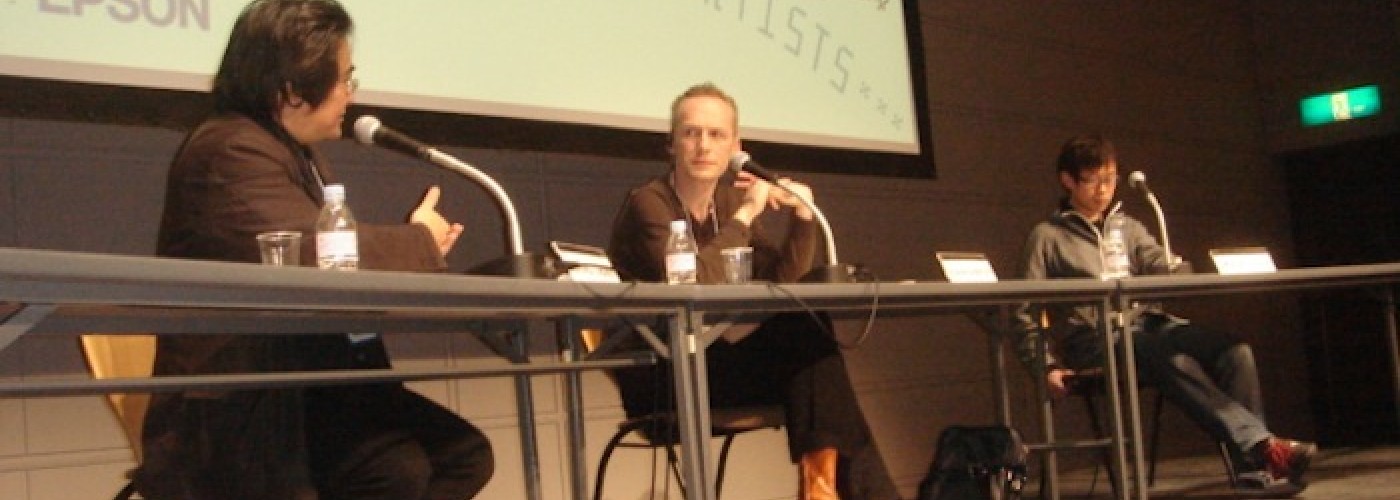Keynote Session: Contemporary Performing Arts
March 3rd 2008[Mon]10:30-12:00 / Yebisu The Garden Room
Discussion on the possibility of performing arts in the age of dynamic migrations of peoples from diverse cultural backgrounds.
Video Lecture - On the Historicality of Japanese Contemporary
March 3rd 2008[Mon]13:30-15:30 / Yebisu The Garden Room
Recently, performing arts that seem to have “thought from outside” are emerging. It seems that they are trying to examine their own standpoint through actively making conversations with cultures of outside. There seems to be another tendency that generated from this – “testimony” as a method. “Theatre of testimony,” which tries to face the facts of “otherness” and to regain speeches in order to recover the power of theatre, is actually the basis of theatre that aims to think with pleasure. I would like to talk about this new resistance against globalized society that has lost the function of thought and reflection, remembering the thought of Walter Benjamin, who said “It cannot be said that there is no hope.” Video materials planned to be used: Gekidan Kara-gumi / NODA・MAP / Gekidan Kaitaisha / Molecular Theatre, and more.
Video Lecture - Extension of Butoh and Emergence of Contemporary Dance: The Body in Dance in Japan Today
March 3rd [Mon] 16:30-18:30 / Yebisu The Garden Room
Taking HIJIKATA Tatsumi’s “Kinjiki” (1959) as its beginning, the history of butoh has been as long as a half century. Butoh emerged in Japan and has spread worldwide drawing international attention, and now “butoh festivals” are actually held in cities far from Japan. There must be certain reason why butoh did not end up in narrow self-orientalism but became an important style of dance. What was the question that butoh posed against “the body” or “dance”? This lecture also considers Japanese contemporary dance since the mid 1980s, of which development is very unique and could be related to or without any relation to butoh.
Video materials planned to be used: “Kijiki” by HIJIKATA Tatsumi, “Kaiin no Uma” by Dairakudakan, works by Sankaijuku, “Le sacre du printemps” by H. Art Chaos, “Noiject” by TESHIGAWARA Saburo, “O/R” by dumb type, “Kinjiki” by ITOH Kim, “no direction” by Nibroll
Potential of Contemporary Drama using Methods of Japanese Traditional Performing Arts
March 3rd 2008 [Mon] 16:30-18:30 / Studio A, Setagaya Public Theatre
Part 1: About Setagaya Public Theatre
Introduces the Setagaya Public Theatre and its productions since its opening in 1997 using video materials.
Part 2: Projects of NOMURA Mansai as an artistic director of Setagaya Public Theatre
Introduces his projects since 2002 and his own creations using video materials.
Contemporary Performing Arts- From Perspective of Europe and Americas
March 4th 2008 [Tue] 10:00-12:00 / Yebisu The Garden Room
The word 'contemporary' in performing arts can sometimes cause confusion as well as suggesting interesting questions for artists, critics and audiences:
Does it relate to work created 'now' and which connects to current national or global themes and issues? Is it concerned with the artist's subversive relationship to 'tradition' which can be identified throughout the history of artistic production? When the avant garde becomes orthodox, does its significance change? How do young artists build on the legacy of their avant garde predecessors?
This session will be an opportunity to explore these and other questions, taking into account that the idea of contemporary performing arts is distinct across cultures. We propose to make a short overview of contemporary Western performing arts, taking the last hundred years as a rough time frame, and examine how artists respond to the shifting challenges of reflecting their culture and engaging their audiences.
Potential of Space -“Playground for Artists”
March 4th 2008 [Tue] 13:30-15:30 / Yebisu The Garden Room
Realization of a performance requires architectural hardware (venue) and software (opportunity). While the hardware mainly belonged to the privileged classes such as aristocrats and samurais before the 19th century, public halls developed and rapidly became gigantic in the 20th century. The software was divided into genres and each genre became specialized in its own venues and contents also in the 20th century. Now, in the 21st century, “spaces” where venues and artists are in mutual activation and cultivation are emerging and trying to break through old frameworks. This session, in free-talking style, considers some actual examples of such “spaces” that are managed in both private and public basis.
What is Site-Specific Work?
March 4th 2008 [Tue] 13:30-15:30 / Maison Franco-Japonaise Hall
Works that are based on a specific site are emerging in festivals across the world, and coincidentally with changes in technologies and cultural policies, these works have new notions of “production” and “audience.” A performance with one viewer in a moving vehicle, or a dining table as the “stage” and dining chairs as “seats” for audience... Guests who have been producing this kind of works explain the idea.
Re-questioning Contemporary Notions of “Europe” and “Asia” -Gestures, Network, and Economy
March 4th 2008 [Tue] 16:30-18:30 / Yebisu The Garden Room
Now that the end of Cold War, post-colonialism and globalization have changed the notion of “Europe” and “Asia,” EU and East Asian Community are constantly reformed as economical blocks with thorough networking rather than political domains or cultural identity.
In this situation, in terms of performing arts, what is the central issue of the relation between Europe and Asia? In the time of information technology and mobility that causes interference among individual bodies, history and capital, what kind of change is our imagination going through? This discussion examines politics around the Other, power, market and the body through plural individuals’ eyes.
Networking in the Age of Mobility
March 5th 2008 [Wed] 11:00-13:00 / Maison Franco-Japonaise Hall
It could be said that performing arts as an art form is not suitable for being “mobile,” and this might be one of the reasons why human networking is indispensable to it. This is a discussion on networking in the age of “mobility” with panelists who have actually been building unique networks.

